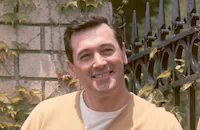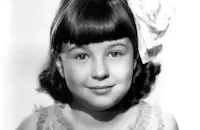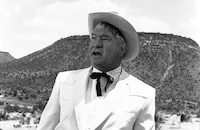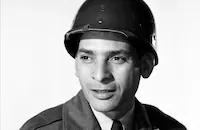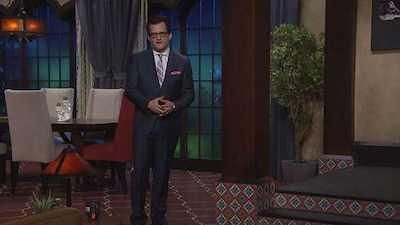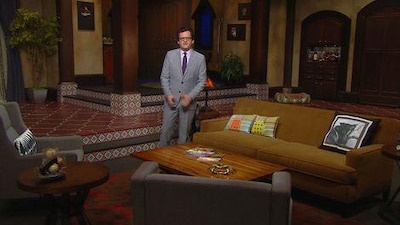Giant airs on Wednesday, March 30th at 2:30 PM
When Giant was released in 1956, ads for the film heralded it as “A picture of proud people… A love story… A cavalcade… A conflict of creeds… A personal drama of strong longings… A big story of big things and big feelings…”
Giant, based on the 1952 novel by Edna Ferber, was all that, and more.
On the surface, the movie is an entertaining family saga that spans generations and sweeping cultural changes in the state of Texas. In some ways it prefigures such narratives as the TV soap opera Dallas.
On a deeper level, Giant (clocking in at 201 minutes) is a serious study of issues not often addressed in films of the 1950s.
These include the equality of women, class warfare, the dangers of rampant materialism, the corrupting influences of power and wealth and, perhaps most importantly, the scourge of racial prejudice.
The film received 10 Academy Award nominations with one win for George Stevens as Best Director, an honor he had previously achieved for A Place in the Sun (1951).
Other Oscar nominations for Giant included those for Best Picture (with the award going to Around the World in 80 Days), Actor (Rock Hudson and James Dean) and Supporting Actress (Mercedes McCambridge).
Rounding out the nominations are Adapted Screenplay (Ivan Moffat and Fred Guiol), Music Score (Dimitri Tiomkin), Art Direction, Color (Boris Leven and Ralph S. Hurst), Costume Design, Color (Moss Mabry and Marjorie Best), and Film Editing (William Hornbeck and others).
Many were surprised at the time that Elizabeth Taylor was not included with a nomination as Best Actress, since the story of Giant is told from her viewpoint. Remaining thoroughly in character in a long and challenging role, she becomes the soul of the film.
Other cast members include Carroll Baker, Chill Wills, Dennis Hopper, Alexander Scourby, Paul Fix, Judith Evelyn, Rod Taylor, Sal Mineo, Earl Holliman, and Elsa Cárdenas.
Giant itself, produced by Stevens and Henry Ginsberg for Warner Bros., became a four-year journey for Stevens. For his grandiose version of Edna Ferber’s novel, he spent two years in preparation, a year of filming and another year of post-production work.
The film also became part of a larger voyage for the director, as recounted by George Stevens Jr. in his documentary about his father, George Stevens: A Filmmaker’s Journey (1984).
Before WWII, the elder Stevens – whose early film experience came as a writer, cameraman and creator of slapstick comedy shorts at the Hal Roach Studios – had become known as a consummate creator of movie entertainments.
He directed musicals (Swing Time, 1936), adventure films (Gunga Din, 1939), comedies (Vivacious Lady, 1938) and romances (Penny Serenade, 1941).
As a lieutenant colonel in the Army during the war, Stevens headed the Special Coverage Unit of the Army Signal Corps to provide documentary coverage of the D-Day invasion, the liberation of Paris, and most sobering, the freeing of prisoners at the Dachau concentration camp.
After the war, Stevens no longer had the heart for lightweight fare and turned to more serious subjects, plumbing ever greater depths as a filmmaker.
The 1950s were his crowning decade, beginning with A Place in the Sun (a film version of Theodore Dreiser’s An American Tragedy), continuing with the elegant, elegiac Western Shane (1953) and culminating with The Diary of Anne Frank (1959).
Amid this evolution came Giant, often considered Stevens’ masterpiece. It’s a film in which the leading characters embark on fateful journeys of their own.
Taylor’s spirited Leslie Lynnton makes an odyssey from the verdant hills of Maryland, where she’s the pampered elder daughter of a genteel family, to the arid plains of West Texas, where she arrives as the bride of cattle rancher Bick Benedict (Hudson).
As she struggles to become the mistress of Reata, Bick’s sprawling ranch, Leslie must cope with a stark environment and a boisterous, sometimes intolerant culture that are completely outside her experience – as alien to her as if she had traveled halfway round the world.
One of the unforgettable images from this richly visual film is the sight of the newly married Benedicts kicking up a huge funnel of dust from their car as they barrel toward an enormous three-story Victorian mansion that sits in solitary and forlorn splendor on the edge of an endless horizon.
The house, with an interior that changes through the decades as the action of Giant moves through the halcyon days of cattle ranching in the mid-1920s to the oil-rich 1950s, is the central symbol of everything Leslie finds grotesque yet oddly engaging about her new home.
The journey for the Hudson character is an inward one. Ranch owner Bick, under the dogged influence of his wife, progresses from an overlord with little concern for the dignity, health or welfare of his Mexican ranch-hands and servants to a tolerant and loving grandfather of a half-Mexican baby.
In a compelling, scene-stealing performance, Dean plays Jett Rink, the surly hired hand who secretly loves Leslie but despises Bick.
Like real-life wildcatter tycoon Glenn Herbert McCarthy (1907-1988), on whom Ferber partly based the character, Jett strikes oil and becomes extravagantly wealthy. As played by Dean, Jett is a Texas “good ol’ boy” who cannot handle his sudden fortune.
An exhilarating fight scene near the end of the film has Bick confronting the owner of a diner who has humiliated a Mexican family. This fellow Texan is even more prejudiced and physically powerful than Bick himself.
In a touching final speech, Leslie confirms that her husband never stood so tall in her eyes as when, in doing the right thing, he was knocked flat on the floor of the diner.
The movie seems prescient in its closing shot, anticipating the growing Latino influence in the American Southwest with a huge close-up of the grandson’s beautiful brown eyes as “The Eyes of Texas Are Upon You” plays gently on a music box in the background.
Although Ferber’s novel had stirred up considerable controversy among residents of the Lone Star state, Stevens had announced in late1953 that location filming for Giant would occur mainly in Texas.
(Some early scenes were shot on the Belmont Farm in Keswick, Virginia, standing in for Leslie’s Maryland home.)
In June 1955, the cast and crew of Giant arrived in Marfa, the closest town to the property Stevens had chosen to represent Reata – the Ryan Ranch, a working cattle ranch in southwestern Texas.
Marfa, the county seat of Presidio County, is located on a Chihuahuan Desert plateau in Texas’s Trans-Pecos area. Once described as a “blink of a town,” it was established in 1883 as a railway water stop, with a population that has fluctuated over the decades.
After Giant, Marfa became the location for such other films as There Will Be Blood (2007), No Country for Old Men (2007), and Marfa Girl (2012). The town has become a tourist attraction thanks to its cuisine, avant-garde art, and the mysterious “Marfa lights.”
Other filming sites for Giant included nearby Valentine, which stood in for the film’s Mexican village, Vientecito and another area along Highway 90 that served as Little Reata, the property on which James Dean’s character, Jett Rink, strikes oil.
Art director Boris Leven based his design for the Reata ranch house on an actual structure, the Victorian-era “Waggoner Mansion,” which still stands today in Decatur, Texas, northwest of Fort Worth.
In an interview with this writer, Leven said that when he showed Stevens his sketch of the imposing house on the otherwise empty plain, the director embraced him and exclaimed, “Partner, this is the best damned thing that’s happened to this picture!”
Technicians at Warner Bros. in Burbank, Calif., had constructed the exterior façade of Reata at a cost of $100,000. The set measured 83 feet across, with a tower that reached up 64 feet. It was shipped by train to Marfa, taking up six flat cars, and erected on the ranch as a three-sided structure supported by six telephone poles.
When location filming was completed and the company left Texas, the façade was left standing (an oversight, according to Leven) and became an inadvertent tourist attraction. Over the years, the desert winds had their way with the structure, and it gradually deteriorated until only the supporting poles were left standing.
These Giant locations became almost sacred ground to ardent fans of the film with many, including this writer, making pilgrimages to the sites. When I was there some 18 years ago, Reata had all but disappeared.
However, Jett’s improvised gateway to Little Reata, and the famous windmill from which he surveys his property in the film, were still standing.
The windmill was meant to look ramshackle even when the movie was made, but since a valuable young actor would be climbing onto it, the studio technicians had crafted it to be solid and sturdy.
Giant caught the imagination of a variety of writers, and the ruins of Reata figured prominently in at least two movies.
The Ed Graczyk drama Come Back to the 5 and Dime, Jimmy Dean, Jimmy Dean (1982), has Sandy Dennis as a Dean-obsessed fan who collects pieces of the crumbling façade.
Kevin Reynolds’ Fandango (1985), a Vietnam-era road movie, features Kevin Costner as part of a gang of pals who spend the night at the movie location during a coming-of-age jaunt across Texas.
In addition, Texas author Billy Lee Brammer wrote a fictional version of the making of the movie in the final section of his critically praised 1961novel, The Gay Place; and Tino Villanueva created a book-length poem in 1995 with Scene from the Movie Giant.
In 2018 another Texas author, Don Graham, published a book about the film, Giant: Elizabeth Taylor, Rock Hudson, James Dean, Edna Ferber and the Making of a Legendary American Film.
Three documentaries were created about the making of the film: Kirby Warnock and Jim Brennan’s Return to Giant (2003), George Stevens Jr.’s Memories of ‘Giant’ (1998), and Hector Galan’s Children of Giant (2015).
In 2005 Giant was selected for preservation in the United States National Film Registry by the Library of Congress as “culturally, historically, or aesthetically significant.”
The 2022 TCM Film Festival, scheduled for April 21-24 in Hollywood, will feature the world premiere of a new restoration of Giant.
The film marked important passages in the careers and lives of its three young stars, all of whom were tackling their most demanding roles as characters who age 25 years during the film.
Taylor, then 23, graduated from lovely MGM ingénue and leading lady to mature acting talent and superstar in this, her first “epic” movie.
For 29-year-old Hudson, a contract player at Universal-International, the movie was even more of a quantum leap, providing the role of a lifetime and garnering him his only Oscar nomination.
The two stars became great friends and would remain close until Hudson’s death from AIDS-related complications in 1985.
Dean, 23, finished out a trilogy of mercurial, exciting performances that also included those in East of Eden and Rebel Without a Cause (both 1955). The actor could be as thorny and difficult as his characters, although he too found a friend and confidante in Taylor.
Dean reportedly clashed with Stevens at times but seemed to incorporate the resulting tension (which the director may have deliberately created) into his quirky and volatile character.
Stevens had extracted a promise from Dean, who loved racing cars and motorcycles, that he would not drive either while Giant was in production. Dean remained true to his word through completion of principal photography involving his character.
But on September 30, 1955, enjoying the freedom to drive his Porsche Spyder, he collided with another car near Cholame, Calif., and was killed instantly.
For this brilliant, meteoric and ultimately tragic young actor, the journey had ended.






